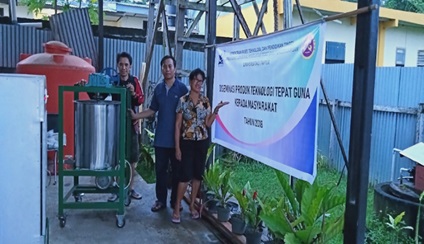Diseminasi Teknologi Tepat Guna Pengembangan Produk Olahan Sagu untuk Peningkatan Ekonomi UMKM di Kabupaten Manokwari - Papua Barat Dissemination of Appropriate Technology for Sago Processed Product Development to Improve the UMKM Economic in Manokwari - West Papua
Main Article Content
Abstract
Sago utilization in Papua has not been maximized due to the limited knowledge and abilities of local communities. This technology dissemination activity aims to increase the utilization of local Papuan resources as a substitute for wheat, by applying the equipment and processing methods that have been developed. The method used is tool dissemination and training on sago starch modification and the manufacture of various processed products in the development of business units. Prototype technology disseminated in the form of starch acidification equipment and drying equipment with UV irradiation. The trial results showed that the capacity of the acidification tool produced was 50 kg of wet sago starch (50% moisture content) with an acidification process duration of 3 days. Meanwhile, the capacity of the dryer is 25 kg of wet sago starch (50% moisture content) with a drying time of ± 20 hours. The use of disseminated tools can reduce material contact with contaminant sources resulting in better product quality.
Downloads
Article Details

This work is licensed under a Creative Commons Attribution-ShareAlike 4.0 International License.
Authors who publish with this journal agree to the following terms:
- Any article on the copyright is retained by the author(s).
- Author grant the journal, right of first publication with the work simultaneously licensed under a Creative Commons Attribution License that allows others to share work with acknowledgment of the work authors and initial publications in this journal.
- Authors are able to enter into a separate, additional contractual arrangements for non-exclusive distribution of published articles of work (eg, post-institutional repository) or publish it in a book, with acknowledgment of its initial publication in this journal.
- Authors are permitted and encouraged to post their work online (e.g., in institutional repositories or on their websites) prior to and during the submission process, as can lead to productive exchanges, as well as earlier and greater citation of published work.
- The article and any associated published material is distributed under the Creative Commons Attribution-ShareAlike 4.0 International License
References
Dewi, A. M. P., Tethool, E. F., & Jading, A. (2014). Physiscochemical and baking expansion properties of peroxide oxidized sago starch with different UV irradaistions. Asian Journal of Food and Agro-Industry, 7(1), 6–12.
Díaz, A., Dini, C., Viña, S. Z., & García, M. A. (2018). Technological properties of sour cassava starches: Effect of fermentation and drying processes. Lwt-Food Science and Technology, 93, 116–123. http://dx.doi.org/10.1016/j.lwt.2018.03.029
Haryanto, B., & Pangloli, P. (1991). Potensi dan Pemanfaatan Sagu. Kanisius. Yogyakarta.Indonesia.
Kurdziel, M., Królikowska, K., Łabanowska, M., Pietrzyk, S., & Michalec, M. (2020). The effect of thermal and irradiation treatments on structural and physicochemical properties of octenyl succinate maize starches. Food Chemistry, 330, 127242. https://doi.org/10.1016/j.foodchem.2020.127242
Kurdziel, M., Łabanowska, M., Pietrzyk, S., Pająk, P., Królikowska, K., & Szwengiel, A. (2022). The effect of UV-B irradiation on structural and functional properties of corn and potato starches and their components. Carbohydrate Polymers, 289, 119439. https://doi.org/10.1016/j.carbpol.2022.119439
Qi, Q., Hong, Y., Zhang, Y., Gu, Z., Cheng, L., Li, Z., & Li, C. (2020). Combinatorial effect of fermentation and drying on the relationship between the structure and expansion properties of tapioca starch and potato starch. International Journal of Biological Macromolecules, 145, 965–973. https://doi.org/10.1016/j.ijbiomac.2019.09.187
Santos, T. P. R. dos, Leonel, M., Mischan, M. M., & Cabello, C. (2021). Study and application of photo-modified cassava starch with lactic acid and UV-C irradiation. LWT - Food Science and Technology, 139, 110504. http://dx.doi.org/10.1016/j.lwt.2020.110504
Teixeira, C. S., Neves, G. A. da R., Caliari, M., & Soares Júnior, M. S. (2019). Waxy maize starch modified by sun-drying after spontaneous or backslopping fermentation. International Journal of Biological Macromolecules, 135, 553–559. https://doi.org/10.1016/j.ijbiomac.2019.05.126
Tethool, E. F., Santoso, B., & Dewi, A. M. P. (2019). Teknologi Pengolahan Ubi-ubian dan Sagu. deePublish. Yogyakarta. Indonesia.
Zhao, T., Li, X., Zhu, R., Ma, Z., Liu, L., Wang, X., & Hu, X. (2019). Effect of natural fermentation on the structure and physicochemical properties of wheat starch. Carbohydrate Polymers, 218, 163–169. https://doi.org/10.1016/j.carbpol.2019.04.061
